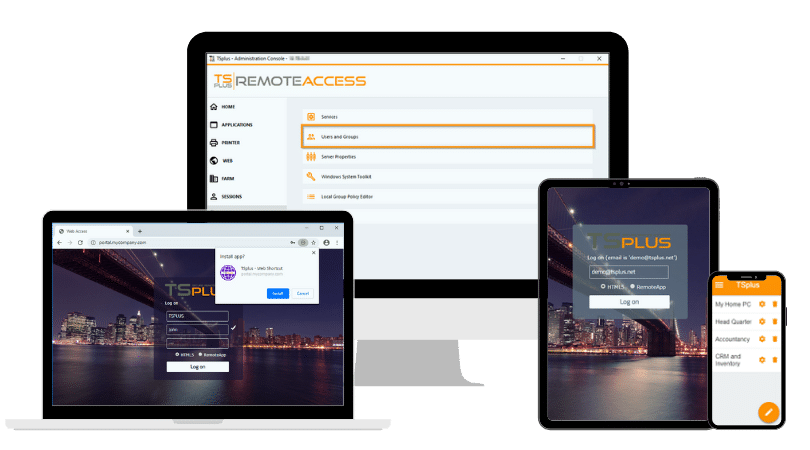)
)
Introduction
RDP is a remote display and input protocol; VDI is an architecture delivering per-user virtual desktops through a broker. Comparing them clarifies transport versus platform: RDP carries pixels, keyboard, and mouse, while VDI defines how desktops are created, isolated, and managed. Choose VDI for strong isolation, customization, and GPU; choose RDP-focused access for simplicity and broad device reach and compatibility.

TSplus Remote Access Free Trial
Ultimate Citrix/RDS alternative for desktop/app access. Secure, cost-effective, on-premises/cloud
What Are RDP and VDI?
- RDP as Transport, Not the Platform
- VDI as Per-User Virtual Desktop Architecture
RDP as Transport, Not the Platform
Remote Desktop Protocol carries pixels, keyboard, and mouse between endpoints and Windows hosts. It is configurable, securable, and widely supported across native clients and browsers. Treat RDP as a transport you harden and optimize; it does not decide multi-tenancy, isolation, or image strategy. That clarity keeps UX tuning separate from platform architecture.
RDP features affect responsiveness and compatibility but remain orthogonal to desktop delivery design. Modern stacks can leverage UDP, adaptive codecs, and granular device redirection policies. These choices shape user experience over variable WAN conditions without dictating whether users land in shared OS sessions or dedicated virtual machines.
VDI as Per-User Virtual Desktop Architecture
Virtual Desktop Infrastructure provisions a dedicated Windows client VM per user—persistent or pooled—via a broker. Isolation extends to kernel and driver layers, enabling conflicting frameworks and GPU attachment. Operations span image lifecycle, profile strategy, capacity management, and access brokering. The payoff is strong separation and deep personalization at higher operational complexity.
VDI’s control plane coordinates provisioning, power policies, placement, and entitlements. Golden images and version rings govern change. Profile containers balance fast logons with personalization depth. GPU profiles and storage tiers align performance with persona needs. The more diverse the app stack, the more VDI’s isolation reduces cross-user collisions.
What Is the Architecture of RDP and VDI?
- How VDI Brokers, Images, and Profiles Work
- What RDP Enables Across Hosts and Devices
How VDI Brokers, Images, and Profiles Work
VDI’s broker authenticates users, maps them to a desktop pool, and orchestrates VM lifecycle. Persistent pools keep long-lived customizations; non-persistent pools reset to clean images each logoff for hygiene. Image pipelines control updates, dependency versions, and rollback. Profile containers carry user state without ballooning logon times.
The storage and GPU planes are central. Write-back caches, profile IOPS budgets, and carefully sized VM templates protect responsiveness during peak hours and login storms. GPU assignment—fractional or dedicated—enables CAD, 3D, and video workflows, while codec offload maintains smoothness at higher resolutions.
What RDP Enables Across Hosts and Devices
RDP enables secure remote access to Windows workloads from managed and unmanaged devices. With gateway termination and TLS, it traverses NATs and firewalls cleanly. Browser-based HTML5 access minimizes endpoint friction, especially for contractors and BYOD. Policy-controlled redirection allows peripherals while keeping data residency on the server side.
RDP’s simplicity accelerates time-to-value. A hardened gateway, identity integration, and sane defaults deliver quick wins: publish the needed desktops or apps, enforce MFA, and avoid raw 3389 exposure. Because endpoints need little more than a browser, onboarding is fast and support overhead stays predictable.
Which Systems Support VDI and RDP?
- VDI for Isolation, Heterogeneity, and GPU
- RDP for Reach, Simplicity, and Speed to Value
VDI for Isolation, Heterogeneity, and GPU
Choose VDI when isolation is non-negotiable, such as regulated environments, risky plug-ins, or kernel-level drivers. Per-VM boundaries confine instability and simplify the handling of conflicting app versions. Teams that run multiple frameworks or toolchains in parallel benefit from the clean separation of state and dependencies.
GPU-intensive tasks-CAD, simulation visualization, media encoding—benefit from assignable GPU profiles and per-desktop tuning. Encoding for remote display is compute-heavy; aligning GPU resources with target personas preserves frame pacing and clarity, even at 4K and multi-monitor setups.
RDP for Reach, Simplicity, and Speed to Value
Use RDP when the priority is broad device reach, minimal client installs, and rapid rollout. Browser-based entry cuts distribution overhead and keeps unmanaged endpoints at arm’s length. For task and knowledge workers on stable application sets, RDP provides excellent productivity with far less platform complexity than full per-VM desktop delivery.
RDP also shines for seasonal or distributed workforces. Contractors and partners can be onboarded quickly with identity-based access and policy-limited redirection. When access ends, identity revocation closes the door without device cleanup, reducing residual risk.
What Is the User Experience of VDI and RDP?
- Network Realities and Codec/Transport Choices
- Devices, Browsers, and Redirection Policies
Network Realities and Codec/Transport Choices
Distance to the workload dominates perceived speed. Placing gateways and workloads close to users trims round-trip time and smooths interactivity. UDP-based transports with adaptive codecs like H.264 or AV1 help during scrolls, video, and rapid UI changes, masking jitter and bursty loss on the public internet.
Conferencing needs validation. Measure Teams or Zoom under real conditions, confirm where A/V processing occurs, and watch CPU during screen sharing. The right optimization path prevents call-time slowdowns that otherwise spike tickets and reduce trust in the platform.
Devices, Browsers, and Redirection Policies
HTML5 access reduces endpoint friction and avoids exposing raw RDP externally. Native clients still have their place for specialized peripherals, but browsers accelerate onboarding for BYOD and short-term users. Maintain a clear client policy so expectations match capabilities across platforms.
Peripheral redirection should be least-privilege by default. Restrict printing, USB, COM ports, drive mapping, and clipboard by role and context. Audit device use in sensitive environments and document exceptions to keep governance predictable and reviewable.
What Security Baselines Should You Enforce with VDI and RDP?
- Edge Hardening and Access Controls
- Segmentation, Telemetry, and Audit Readiness
Edge Hardening and Access Controls
Never expose TCP/3389 to the internet. Terminate TLS at a hardened gateway or reverse proxy, enforce MFA for users and admins, and adopt modern cipher suites. Separate admin entry points from user portals and prefer short-lived credentials with just-enough-administration to reduce lateral movement risk.
Conditional access raises the bar. Tie policies to identity, device posture, network reputation, and geolocation. For unmanaged endpoints, prefer browser-only access with stricter redirection rules. Rotate certificates proactively to avoid silent outages and keep observability around auth failures.
Segmentation, Telemetry, and Audit Readiness
Segment the edge, brokers, and desktop hosts on dedicated subnets. Use least-privilege service accounts with rotation and tamper-protected EDR on all servers. Stream logs to a SIEM, alert on anomalies, and rehearse break-glass procedures. Where needed, enable session recording with appropriate retention and privacy controls.
Audit readiness is operational muscle. Map controls to frameworks you care about, keep evidence fresh, and automate artifact collection. Post-incident, favour blameless reviews that feed directly into image baselines and gateway policies.
What Are the Licensing and Costs of VDI vs RDP?
- VDI Cost Drivers and Capacity Planning
- RDP Operational Costs and Hidden Run-Costs
VDI Cost Drivers and Capacity Planning
VDI concentrates spend in hypervisor or cloud compute, Windows client licensing, broker operations, image lifecycle, profile containers, storage IOPS, and (optionally) GPU. Budget for specialist time to design images, optimize logons, and govern drift. Test login storms, patch windows, and conferencing peaks before broad rollout.
Right-size pools and templates to personas. Use promotion rings for images and hold a rollback inventory. Track real concurrency, not headcount, and model storage tiers for hot, warm, and profile data. The goal is predictable user experience at known monthly run-rate.
RDP Operational Costs and Hidden Run-Costs
RDP reduces platform heft but still carries real-world costs: gateway high availability, certificates, reverse proxying, monitoring, security tooling, and helpdesk time. The biggest hidden cost is policy sprawl—printer mappings, USB exceptions, and per-group redirection tweaks. Standardize defaults and keep exceptions scarce.
Because endpoints can be heterogeneous, document supported clients and test paths. A small matrix of “golden” configurations lowers support variance and speeds incident triage. Keep user education short and visual; fewer surprises mean fewer tickets.
What to Consider for VDI and RDP in Production?
- Operating VDI
- Operating RDP
Operating VDI: Image Governance and Profile Strategy
Image drift is the silent risk. Use semantic versioning, promotion rings, and automated regression tests to keep desktops stable through monthly changes. Profile containers balance personalization with fast logons; monitor IOPS, cache growth, and login duration to catch regressions early.
Capacity is multi-dimensional. Track CPU ready, GPU utilization, storage latency, and protocol metrics per session. Synthetic probes from user locations reveal regional anomalies. Plan maintenance waves and communicate change windows to keep trust high.
Operating RDP: Session Density and Endpoint Variance
RDP scales by adding hosts and optimizing session density. Keep server images lean, trim startup tasks, and monitor per-session CPU/memory to avoid noisy neighbours. Browser-based access simplifies client distribution; native clients remain for advanced peripherals where needed.
Endpoint variance is real. Maintain a short, tested catalog of device and OS combos. Publish troubleshooting steps for displays, DPI, and peripherals so helpdesk can solve issues quickly. Measure success with login time, session latency, and ticket volume, not just server uptime.
What Is the Implementation Checklist for VDI and RDP Deployments?
- Personas, Images, and Secure Edge Design
- Instrumentation, Pilots, and DR Playbooks
Personas, Images, and Secure Edge Design
Define personas first: knowledge worker, GPU user, contractor. Map each to VDI or RDP based on isolation, performance, and duration. Keep image counts minimal and name versions clearly. Design the secure edge with a gateway and reverse proxy, enforce MFA, and avoid exposing raw RDP externally.
Choose protocol features intentionally. Validate UDP transport, adaptive codecs, and conferencing optimizations under peak conditions. Document printer and USB policies per role to eliminate surprises during go-live. Small, well-tested defaults scale better than sprawling policy sets.
Instrumentation, Pilots, and DR Playbooks
Instrument hosts and sessions for CPU, GPU, IOPS, protocol latency, and frame metrics. Add synthetic probes from user locations. Pilot with a diverse cohort and expand by waves after thresholds and policies are tuned. Include the control plane in DR tests; time-to-productivity is the success metric.
How TSplus Fits Your Strategy?
When your goal is to publish Windows applications or full desktops securely to any device, TSplus Remote Access provides a hardened HTML5 Web Portal and Gateway that keep raw RDP off the internet. Built-in MFA, reverse proxy, and policy-controlled redirection protect access while minimizing endpoint friction—ideal for contractors and BYOD.
TSplus focuses on practical, lower-overhead remote access: browser entry, centralized administration, remote printing, and load balancing. You achieve quick wins with fewer moving parts than full per-VM desktop delivery yet retain flexibility to serve demanding users with dedicated resources where needed.
Conclusion
VDI is an architecture for per-user virtual desktops—choose it for isolation, heterogeneous stacks, and GPU-heavy work. RDP is a transport that enables broad, secure reach with minimal client friction—choose it for rapid rollout and predictable operations. Keep the two concepts distinct to avoid over-engineering or under-securing your environment.














)
)
)